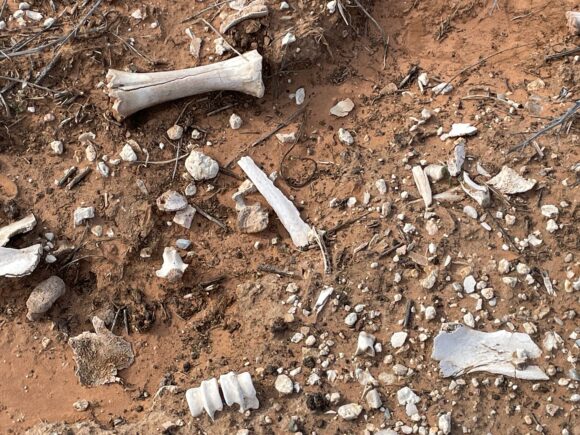Neither Art nor Renee Schaap could bear to stay on their dairy farm in Curry County, New Mexico, in April 2022 as employees put down the last of their cattle, shooting 1,000 in the head one by one with .22 caliber bullets.
Workers dumped the carcasses into a 20-foot-deep trench the length of a football field, creating two layers of rotting corpses that emanated a “smell of death,” Renee said. The soil is riddled with the toxins that killed them.
The herd — once numbering 3,600 — had slowly been dying for years after drinking water contaminated by per- or polyfluoroalkyl substances, known as PFAS, from neighboring Cannon Air Force Base.
The animals became worthless in 2018 when tests found levels of the so-called forever chemicals in the farm’s wells that were up to 23 times higher than the federal drinking water health advisory at the time. Over a two-year period, the Schaaps dumped up to 18,000 gallons of milk a day that couldn’t be sold.
Farmers in the area tried to work with the Air Force to clean up the pollutants but were stunned in 2019 when the base sued New Mexico, saying officials didn’t have the authority to order a cleanup — a legal fight that continues. Meanwhile, a separate battle over Cannon’s culpability has become a bellwether case in national litigation over whether the federal government is liable for the contamination.
A critical hearing is set for Feb. 7 before the US District Court of South Carolina, which is managing thousands of lawsuits claiming property, personal injury and other damage from the foam known as AFFF. The US government has made three related requests to dismiss all claims.
At least 27 businesses, cities, counties, individuals and states have filed claims against the Air Force, Army or Navy under a law called the Federal Tort Claims Act, which describes when the government can be sued.
Additional claims have been filed under the Comprehensive Environmental Response, Compensation and Liability Act, the law popularly known as Superfund, which can force a federal agency to pay back costs expended for cleaning up hazardous substances from highly polluted sites — in this case either of two specific PFAS the military released. More than 580 active military installations need closer investigations as possible Superfund sites, the Pentagon found last year.
If District Judge Richard M. Gergel sides with the government, the Pentagon is off the hook. If he doesn’t accept all of the government’s arguments, litigation for some or all claims would continue.
The stakes in Curry County are high for farmers whose livelihoods are at risk. A few miles past the Schaaps’ Highland Dairy sits Southwest Cheese LLC where more than 5 billion pounds of milk is processed into cheese annually and shipped all over the globe. Its presence underscores agriculture’s dominant role in the area — and the potential impact on farmers and the regional economy if the water contamination isn’t stopped.
The plant has been testing all incoming water for PFAS since 2019, and so far, none has been detected. But locals are concerned about the contamination spreading.Even the region’s sole drinking water source — the Ogallala Aquifer — is at risk.
Meanwhile, Cannon is still contributing to the problem.Last month, New Mexico’s Environment Department ordered Cannon to immediately address and pay a fine for releasing 7,300 gallons of the firefighting foam last year.
Kevin Ferrara, a retired Air Force firefighter who served at Cannon from 1991 to 1995, says every 24-hour shift started with discharging foam across the airfield, the training areas and runways. It would ultimately get washed into a stormwater drain or the soil.
“We were told it was like soap and water,” Ferrara said. “I thought it was fine until after I got out and started doing my own research.”
What he’s since learned, in part from past studies the Department of Defense conducted, frustrates Ferrara, an emergency service consultant who now advocates for firefighter’s health and safety. “They’ve had decades to do the right thing,” he said.
Studies have uncovered some clear warnings about AFFF, though there’s also some uncertainty about other risks. In April 1978, for example, the Naval Facilities Engineering Command highlighted environmental toxicities from AFFF. The memo recommended that the Navy develop toxicity guidelines and effective treatment for the waste as well as research safer forms of fire suppressants made with other chemicals.
The Air Force has made efforts to mitigate PFAS contamination. As of last August, all AFFF was removed from vehicles at the 3,789-acre base and nearby 70,000-acre Melrose, a spokesperson said. PFAS-containing products and residuals have been collected and stored in a controlled holding area while awaiting approved disposal, it said.
Cannon has also provided water filters for three properties where PFAS contamination exceeded the advisory level set in 2016 by the Environmental Protection Agency, a base official said. The EPA doesn’t regulate well water, but last year it limited the amount of two PFAS in public drinking water systems: perfluorooctanoic acid and perfluorooctane sulfonate.
The base is also building a $73 million groundwater treatment plant that is scheduled to start operating in March. The startup has been delayed because some of the electrical components needed have been on order for more than a year, said Christipher Gierke, who oversees environmental restoration efforts at Cannon. The system will eventually be able to treat 86,000 gallons a day, he said.
But there are obstacles. Among them are the lack of approved technologies to destroy PFAS, said Brian Howard, a senior technical advisor for the Deputy Assistant Secretary of the Air Force for Environment, Safety and Infrastructure. Congress has barred the Defense Department from incinerating PFAS-containing waste until it can meet criteria that shows complete destruction, which is still in development.
Another challenge has been the EPA’s steady revision of criteria used to determine how contaminated sites are. So-called screening levels are used by federal agencies, states and companies to examine sites and determine whether chemical concentrations are high enough to cause problems.
Each change meant the Air Force’s contractors had to reexamine bases to determine if the newly added forms of PFAS were present and if the older ones exceeded the revised, lower standard. In 2016, the EPA had set levels for three types of PFAS. Now there are more than a dozen.
Dairy farms at risk of contamination have begun filtering water on their own as they try to keep their businesses going, but it’s expensive and time-consuming, eating into revenue and profits.
And farmers growing crops, along with ones that lease land for cattle to graze, are worried about the impact the toxins will have on their property values, according to Republican state Senator Pat Woods, a rancher whose great- great-grandfather came to New Mexico as a homesteader. “There’s a lot of resentment. You work your whole life to pay for your place,” Woods said. And now “land value is pretty shaky.”
But whether local businesses can claw back the cash spent trying to mitigate the problems themselves remains to be seen.
If the court decides the government can be sued under the Federal Tort Claims Act for alleged harms done as it used and released AFFF, that would open the door to faster cleanups and damage compensation, said Ken Sansone, a senior partner with SL Environmental Law Group PC.
But one of the government’s key arguments to dismiss the Schaap’s and related lawsuits is that agencies’ use of AFFF qualifies for what’s called the discretionary function exception under that law. There were no policies or regulations applied to AFFF for most of the decades it was used, so the government maintains that it’s not liable for its discretionary use of the firefighting foam.
The discretionary function exception “is the biggest hurdle to recovery of tort claims,” said John McGahren, deputy chair of Morgan, Lewis & Bockius LLP’s global environmental practice, which isn’t involved in the multidistrict litigation.
A second key argument the government makes is that the strategy, time and approach it uses to clean up contaminated sites can’t be challenged under CERCLA.
Yet barring states from challenging the length, scope or other aspects of federal Superfund PFAS investigations and cleanups would be “like letting the fox guard the henhouse,” said James Kenney, secretary of the New Mexico Environment Department.
“If you’re allowing the polluter to determine how the cleanup and the notification is done, you’re bound to run into some problems,” said Zachary Ogaz, general counsel for the department. “It is essential that the state has the authority to regulate these types of releases and these types of facilities, because we can’t expect them to hold themselves accountable.”
Some residents and businesses chose not to wait for a verdict to take action. Vance Dewbre, who has a five-acre property near the Schaaps, says he installed a filter for his home at a cost of about $2,000, not counting the annual filter replacements that cost $400.
“You fill up your faucet and wonder if it’s safe to drink,” he said. “That’s something that 99.9% of people don’t have to think about. They know it’s safe. Not us.”
But not everyone can afford that, so the New Mexico Environment Department has asked the legislature for $4 million to provide public water to Curry County residents.
For now, the trench on the Schaap’s land is filled with contaminated cow carcasses. They’ve only avoided bankruptcy because they own two smaller dairies away from Cannon’s pollution. “We just want to move on and have a normal life again,” Art Schaap said.
It weighs on Ferrara’s mind. Theformer Air Force firefighter remembers the Schaap’s farm being just on the other side of the fence surrounding Cannon’s perimeter. “And it’s not just what happened at Cannon. It’s around the country,” he said.
“The chain link fence didn’t hold things back. It got off the base and that affects innocent people. The military has a responsibility to act in a way that holds itself accountable for that.”
Photo: Cow bone fragments surface to the top of a now-covered PFAS containment trench. Photographer: Pat Rizzuto/Bloomberg.
Topics Agribusiness
Was this article valuable?
Here are more articles you may enjoy.



 US P/C Posts $35B YTD Underwriting Gain; By-Line Premium Growth Revealed
US P/C Posts $35B YTD Underwriting Gain; By-Line Premium Growth Revealed  FBI Involved After Two Florida Injury Lawyers Go Missing From Fishing Trip
FBI Involved After Two Florida Injury Lawyers Go Missing From Fishing Trip  Cloudy Future for Bourbon Has Jim Beam Closing Distillery for a Year
Cloudy Future for Bourbon Has Jim Beam Closing Distillery for a Year  CEO Sentenced in Miami to 15 Years in One of the Largest Health Care Fraud Cases
CEO Sentenced in Miami to 15 Years in One of the Largest Health Care Fraud Cases 

